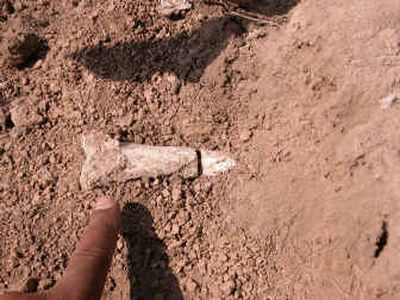Fossils may be remains of our first walking ancestor

ADDIS ABABA, Ethiopia – A team of U.S. and Ethiopian scientists has discovered the fossilized remains of what they believe is humankind’s first walking ancestor, a hominid that lived in the wooded grasslands of the Horn of Africa nearly 4 million years ago.
The bones were discovered in February at a new site called Mille, in the northeastern Afar region of Ethiopia, said Bruce Latimer, director of the Cleveland Museum of Natural History in Ohio. They are estimated to be 3.8-4 million years old.
The fossils include a complete tibia from the lower part of the leg, parts of a thighbone, ribs, vertebrae, a collarbone, pelvis and a complete shoulder blade, or scapula. There also is an ankle bone which, with the tibia, proves the creature walked upright, said Latimer, co-leader of the team that discovered the fossils.
The bones are the latest in a growing collection of early human fragments that help explain the evolutionary history of man.
“Right now we can say this is the world’s oldest bipedal (an animal walking on two feet) and what makes this significant is because what makes us human is walking upright,” Latimer said. “This new discovery will give us a picture of how walking upright occurred.”
The findings have not been reviewed by outside scientists or published in a scientific journal.
Paleontologists previously discovered in Ethiopia the remains of Ardipithecus ramidus, a transitional creature with significant ape characteristics dating as far back as 4.5 million years. There is some dispute over whether it walked upright on two legs, Latimer said.
Scientists know little about A. ramidus. A few skeletal fragments suggest it was even smaller than Australopithecus afarensis, the 3.2 million-year-old species widely known by the nearly complete “Lucy” fossil, which measures about 4 feet tall.
Scientists are yet to classify the find, which they believe falls between A. ramidus and A. afarensis. The fossils would help “join the dots” between the two hominids, said Yohannes Haile-Selassie, an Ethiopian scientist and curator at the Cleveland Museum of Natural History as well a co-leader of the team.
“This discovery will tell us much about how our 4-million-year-old ancestors walked, how tall they were and what they looked like,” he said. “It opens the door on a poorly known time period and (the fossils) are important in that they will help us understand the early phases of human evolution before Lucy.”
The specimen is only the fourth partial skeleton ever to be discovered that is older than 3 million years. It was found after two months of excavation at Mille, 37 miles from the famous Lucy discovery.